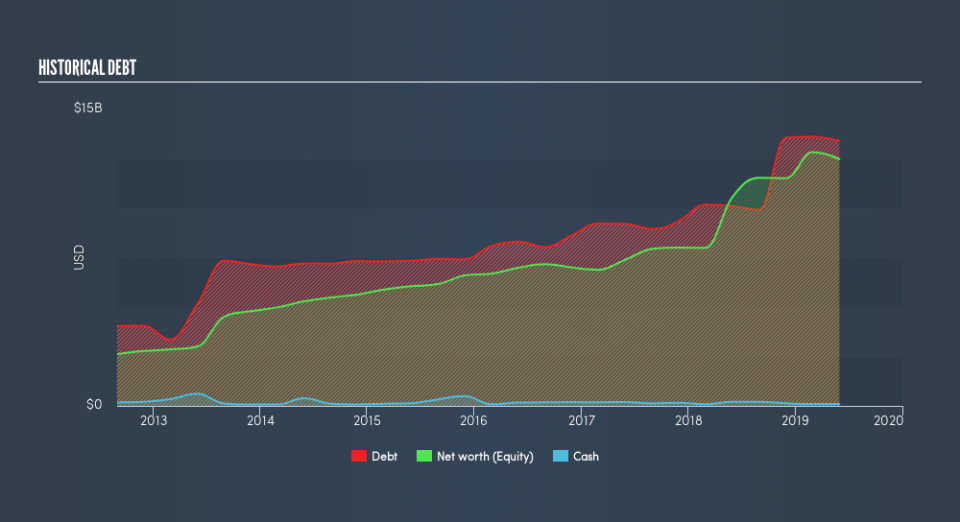Is Constellation Brands, Inc.'s (NYSE:STZ) Balance Sheet A Threat To Its Future?

The size of Constellation Brands, Inc. (NYSE:STZ), a US$38b large-cap, often attracts investors seeking a reliable investment in the stock market. Market participants who are conscious of risk tend to search for large firms, attracted by the prospect of varied revenue sources and strong returns on capital. However, its financial health remains the key to continued success. Today we will look at Constellation Brands’s financial liquidity and debt levels, which are strong indicators for whether the company can weather economic downturns or fund strategic acquisitions for future growth. Remember this is a very top-level look that focuses exclusively on financial health, so I recommend a deeper analysis into STZ here.
Check out our latest analysis for Constellation Brands
STZ’s Debt (And Cash Flows)
STZ's debt levels surged from US$10b to US$14b over the last 12 months , which includes long-term debt. With this increase in debt, the current cash and short-term investment levels stands at US$99m to keep the business going. On top of this, STZ has produced US$2.3b in operating cash flow in the last twelve months, resulting in an operating cash to total debt ratio of 17%, indicating that STZ’s debt is not covered by operating cash.
Can STZ pay its short-term liabilities?
At the current liabilities level of US$2.9b, it seems that the business has maintained a safe level of current assets to meet its obligations, with the current ratio last standing at 1.22x. The current ratio is the number you get when you divide current assets by current liabilities. Generally, for Beverage companies, this is a reasonable ratio since there is a bit of a cash buffer without leaving too much capital in a low-return environment.
Does STZ face the risk of succumbing to its debt-load?
Constellation Brands is a highly levered company given that total debt exceeds equity. This is common amongst large-cap companies because debt can often be a less expensive alternative to equity due to tax deductibility of interest payments. Consequently, larger-cap organisations tend to enjoy lower cost of capital as a result of easily attained financing, providing an advantage over smaller companies. We can assess the sustainability of STZ’s debt levels to the test by looking at how well interest payments are covered by earnings. As a rule of thumb, a company should have earnings before interest and tax (EBIT) of at least three times the size of net interest. In STZ's case, the ratio of 6.79x suggests that interest is well-covered. It is considered a responsible and reassuring practice to maintain high interest coverage, which makes STZ and other large-cap investments thought to be safe.
Next Steps:
STZ’s debt and cash flow levels indicate room for improvement. Its cash flow coverage of less than a quarter of debt means that operating efficiency could be an issue. Though, the company exhibits proper management of current assets and upcoming liabilities. I admit this is a fairly basic analysis for STZ's financial health. Other important fundamentals need to be considered alongside. You should continue to research Constellation Brands to get a more holistic view of the stock by looking at:
Future Outlook: What are well-informed industry analysts predicting for STZ’s future growth? Take a look at our free research report of analyst consensus for STZ’s outlook.
Valuation: What is STZ worth today? Is the stock undervalued, even when its growth outlook is factored into its intrinsic value? The intrinsic value infographic in our free research report helps visualize whether STZ is currently mispriced by the market.
Other High-Performing Stocks: Are there other stocks that provide better prospects with proven track records? Explore our free list of these great stocks here.
We aim to bring you long-term focused research analysis driven by fundamental data. Note that our analysis may not factor in the latest price-sensitive company announcements or qualitative material.
If you spot an error that warrants correction, please contact the editor at editorial-team@simplywallst.com. This article by Simply Wall St is general in nature. It does not constitute a recommendation to buy or sell any stock, and does not take account of your objectives, or your financial situation. Simply Wall St has no position in the stocks mentioned. Thank you for reading.


